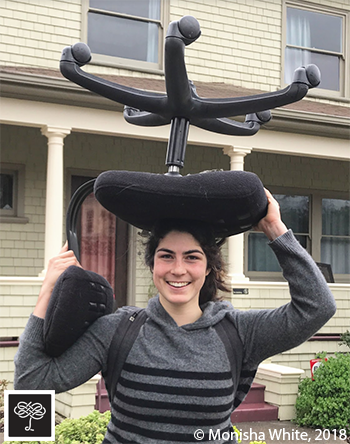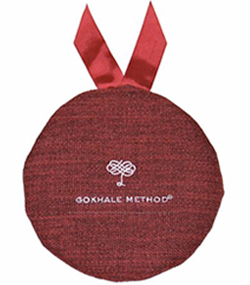4 Benefits of Carrying on the Head
Carrying weight on the head is a primal activity, something we have done for millions of years.

Transporting water in the Ouahigouya marketplace, Burkina Faso, 1998.
I took an archeology course at Stanford from professor John Rick that included a workshop on stone knapping (chipping away at a stone to create arrowheads and similar tools). While most of us created pitiful arrowheads with no chance of any hunting success, a few members of the class hit the obsidian at productive angles that resulted in decent weapons. Professor Rick says that about 10 percent of his students intuitively know how to make good arrowheads. He believes that the relevant DNA for being good at this task has been conserved through the generations in these individuals. Making stone tools like arrowheads was essential in our past, with the “tool kit” remaining unchanged for a surprisingly long period of a million years in the archaeological record. Given this length of time, and the utility of being able to create good arrowheads, it makes sense that this ability would have been naturally selected for. For most societies, It’s been quite a long time since we needed this ability, and most of us have lost the genetic traits that support making good arrowheads, but it seems that in a small percentage of us, the relevant code persists.
I believe a similar situation holds true for carrying on the head. People have carried on their head for a very long period of time, and have continued to do so until very recently (it’s still important in some areas of the world.) My experience with students is that for almost everyone, a small weight on the head acts as a cue for neck and back stabilizer muscles to engage. This protects the spine from compression. It is striking that this complex muscular response is intact even when we have gone our whole lives without the signal-response being activated.

Gokhale Method teacher Monisha White modeling carrying on her head
Benefits of carrying weight on your head:
1. Helps you find your axis
Locating the spot on the crown of the head is easy (see video on this page), and once you apply a weight there, you have a very visceral sensation of your vertical axis. The weight acts as a stimulus to line up the relevant bones / joints; misalignment is suddenly very palpable as your muscles work harder than you are used to against the weight. If your head has drifted forward, your neck muscles are dealing with a lot of torque, which is inefficient and feels tiring; the body naturally corrects to be most efficient.

Carrying significant weight on the head necessitates lining up your bones and joints well.
2. Strengthens your longus colli muscles in the neck
When you apply a weight on the head, it serves as a cue to engage your stabilizer muscles. The weight strengthens your longus colli muscle (deep in the neck) as well as your inner corset muscles throughout the torso. These help brace the body, like a column, under the weight. These are the muscles that support and brace your spinal column to prevent compression during physical activities, so strengthening them will make you more resistant to wear and tear as well as injury.

This young Burkina mom keeps herself strong with all that she carries.
3. Helps relax your superficial neck muscles
We tend to overuse our superficial neck muscles, especially the levator scapulae, scalene, sternocleidomastoid, splenius, and trapezius muscles. When the stabilizer muscles are cued to take back their responsibility for supporting the head and neck, the more superficial muscles of the neck can relax better.

Carrying weight on the top of your head helps activate deep neck stabilizer muscles and is surprisingly relaxing for superficial neck muscles like the scalenes.
4. Evokes a feeling of groundedness
Perhaps because of the primal nature of carrying weight on the head, I have heard from and seen in many students, and experienced myself, that placing a weight on the head has a centering and grounding effect. The feeling seems to help the mind remain engaged and present with the physical, and is quite calming. Much like meditation, it helps quiet overthinking and background noise in the mind, and creates a space to focus just on the sensations in the body.

Once you’ve built up the proper muscles, you can carry larger objects.
I used to use a folded sweatshirt or blanket to practice, but got tired of sleeves working their way down in front of my eyes and such. Eye pillows don’t center the weight on the crown of the head very well. In 2014, I designed the Gokhale head cushion for more practical extended use. We experimented so it has a useful weight, coefficient of friction (it can fall off the head but not too easily), and hardiness (moisture won’t ruin it). I’ve taken to placing several of them around my home to work as reminders to carry it on my head off and on. I floss my teeth while donning the head cushion in my bathroom; I begin my emails with the head cushion near the communal desk. I’m planning a walk to the Stanford dish with a cushion, now that my neck is getting stronger.

The Gokhale head cushion was born in 2014 and helps thousands of people find a healthy axis in their necks and bodies
Do you ever wear any weight on your head? How do you remind yourself to do this practice? What object do you use?

Comments
I would guess that we learn
I would guess that we learn to use our muscles in this way as soon as we begin to sit. Babies’ heads are very large and heavy in relation to their bodies, so they instinctively centre the weight of the head well on the support of the spine. The natural muscular actions involved are perhaps even further developed by head-loading. It’s such a shame that in our culture we usually lose the ability to ‘carry our heads’ well through poor posture, resulting in spinal distortions, forward head carriage, etc. Bring on the head cushion!
I do wear weights on my head.
I do wear weights on my head. I started doing it when I first saw your videos and afterward I read your book, reinforcing the idea. I love it. It’s the most useful thing (among many other useful things) I’ve learned from you. I started off with a buckwheat pillow, because I could squish it around and have it stay on more or less, and at first I used it while on my computer or playing games or watching shows. But afterward I began to walk around the house with it, and eventually I craved a heavier weight, and got up to a 6kg and then a 12 kg kettlebell. Those I hold on to with one hand because it might be dangerous if they fell, but it doesn’t disturb the good posture or the good feeling I get from it. I was eventually able to carry a 24 pack of 500 ml drinks up the stairs to the fourth floor feeling no stress or tiredness. I genuinely believe carrying things on my head is easier than any other way. I’ve been careful and slow but I’ve never had a single headache or neck ache with this method, I only feel invigorated and strong!
In Bali, the ladies all carry
In Bali, the ladies all carry heavy objects on their heads as part of their culture, frequently with elaborate offerings in processions. Many find employment transporting heavy loads that way, or stand in the market with their produce that they are selling atop their head. Mountain guides will walk from one peak to another with a jar of water atop their head to boil for tea and socialize with one another.
In Japan, like America, no one does that. Many elderlyJapanese ladies develop severe osteoporosis of the spine, until they are bent nearly double. The western remedy, hormones and poorly tested drugs, strike me as undesirable, but as an active woman I truly fear osteoporosis. None of the ladies in Bali has a bent back. You see little old ladies carrying heavy loads on their heads on a daily basis , and they all sway beautifully as they walk.
Therefore, I don't care if I get funny looks. I use every opportunity to carry moderate or even heavy loads. At the supermarket, I put my purchase in a cardboard box, head it, and hie on up the stairs with it (beware of automatic doors!), and use a basket to carry vegetables from our field home. I tuck my chin enough to be able to see my entire foot peripherally as I extend it in walking, and stairs either up or down are no problem. When travelling, I use a backpack, but also carry my larger bag atop my head for short spells rather than get a cart at the airport. My husband lets me carry things. It really ought to be a lady's job!
I have been keeping an eye out for a decent head cushion. I bought one in Bali, but it is ceremonial and slippery, really only good for people who have practiced since childhood. (The ladies there are downright acrobatic.) The Gokhale head cushion looks just like what I need.
I had my bone density tested a year ago, and my spine was denser than that of an average 20 year old (I'm 60). A few years back, I had sudden lower back pain during a trip abroad that made it very hard to move, but I found that if I carried a load on my head, I felt much better immediately and healed soon. Recently, when I told a doctor I was exercizing this way, he told me in no uncertain terms that I must not. I'd hurt my neck, he said. If I ever see him again, I'll bring this article.
I lived in Japan and I never
I lived in Japan and I never saw anyone carry anything on their head, unlike other Asian countries. I've looked at hundreds of Woodblock prints and never saw anyone doing so. So, I fully agree with your observation. Conversely, I used the sumo wrestlers as guides to help with my posture and injuries well before finding the GM because it's seems very yoga-like in so many ways. Something I want to think about more. I'm a great fan of carrying things on my head and often do so on way home from grocery store.
I've started doing this, and
I've started doing this, and I can tell that it is improving my posture. I carry plastic buckets with sand or leaves in them this way, when I gather them on my walks. I have a question though: why are only women shown doing this, around the world? Do men NOT carry things on their heads? Is this part of being a beast of burden for women in the world? This is not to say that it is unhealthy, just that carrying water, etc, seems to have been relegated to women perhaps because of their low status world-wide.
Add New Comment
Login to add commment
Login